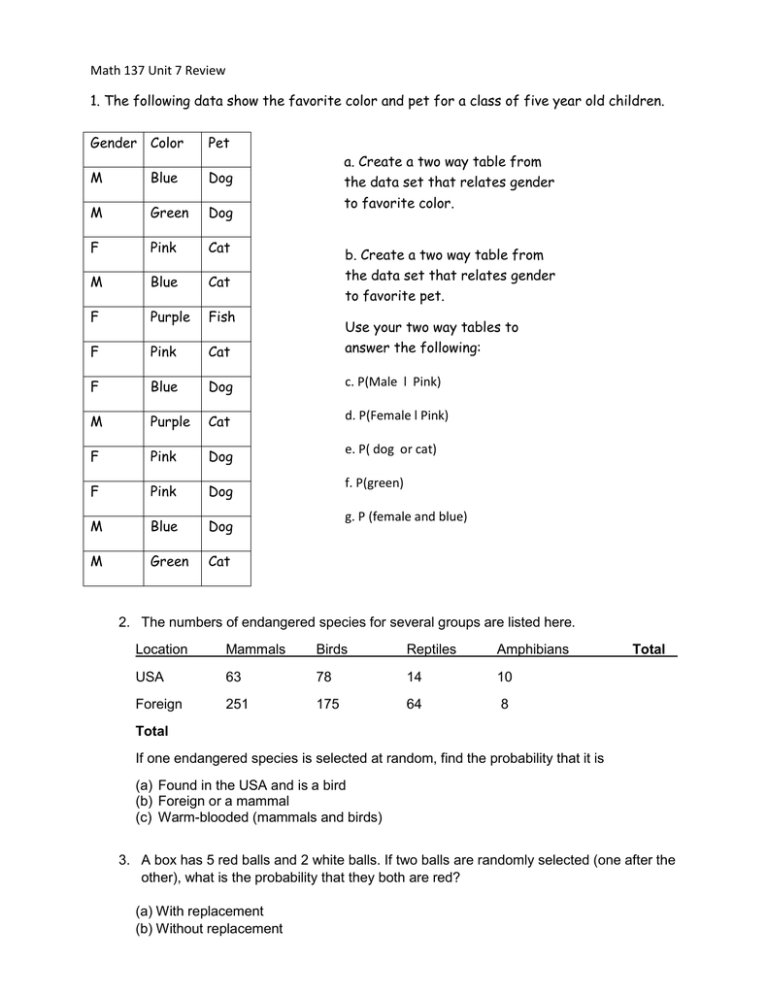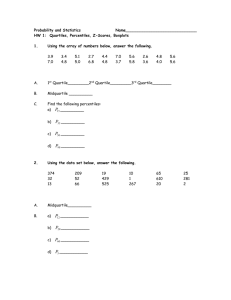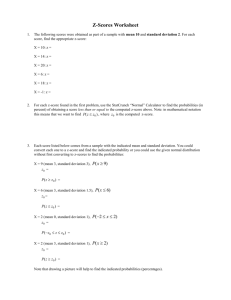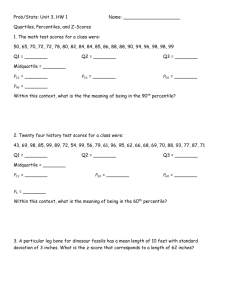Math 137 Review Unit 7.docx
advertisement

Math 137 Unit 7 Review 1. The following data show the favorite color and pet for a class of five year old children. Gender Color Pet M Blue Dog M Green Dog F Pink Cat M Blue Cat F Purple Fish F Pink Cat answer the following: F Blue Dog c. P(Male l Pink) M Purple Cat d. P(Female l Pink) F Pink Dog e. P( dog or cat) F Pink Dog f. P(green) M Blue Dog g. P (female and blue) M Green Cat a. Create a two way table from the data set that relates gender to favorite color. b. Create a two way table from the data set that relates gender to favorite pet. Use your two way tables to 2. The numbers of endangered species for several groups are listed here. Location Mammals Birds Reptiles Amphibians USA 63 78 14 10 Foreign 251 175 64 8 Total Total If one endangered species is selected at random, find the probability that it is (a) Found in the USA and is a bird (b) Foreign or a mammal (c) Warm-blooded (mammals and birds) 3. A box has 5 red balls and 2 white balls. If two balls are randomly selected (one after the other), what is the probability that they both are red? (a) With replacement (b) Without replacement 4. Consider the following Probability Distribution: X 0 P(X) .10 1 ?? 2 .10 3 .20 4 .20 5 .10 (a) Find P(1) (b) Calculate the population mean (c) Calculate the population standard deviation. (d) What is the probability that x is less than 2? 5. A casino in Las Vegas offers the following gambling game. To play you must pay $5. You role a die one time. If you role a 1, 2 or 3, you lose your $5. If you role a 4 or a 5, you win $3. (You get your $5 back plus an additional $3). If you role a 6, you win $7. (You get your $5 back plus an additional $7.) Let X represent the random variable describing the amount of money won or lost and P(x) represent the probability of winning or losing that money. a. Fill out the following probability table with all the missing probabilities. Money Lost or Won -$5 +$3 +$7 P(x) b. Find the expected value for the probability distribution. c. Write a sentence explaining the meaning of the expected value in this context. 6. A box contains three $1 bills, two $5 bills, five $10 bills, and one $20 bill. Construct a probability distribution for the data if x represents the value of a single bill drawn at random and then replaced. 7. This data reflects Honda sales at a car dealership in Northern California. Is the probability that someone purchases a Hybrid Honda independent of whether the buyer is female? Which two proportions are NOT a useful comparison for addressing this question? a. 117 / 311 and 34 / 111 b. 111 / 311 and 34 / 117 c. 117 / 311 and 111 / 311 8. State the mean and the best approximation of the standard deviation of the normal curve shown below. 9. The mean of each probability distribution pictured is 5. Which has the largest standard deviation? 10. 11. 12. 11. Determine the area under the standard normal curve that lies to the right of z 1.98 (using the z tables). 12. Determine the following probabilities for the standard normal random variable z. (a) P(z<1.42) (b) P(-2.46<z<1.74) (c) P(z>2.83) 13. Find the z value that corresponds to the given area. 14. A college intramural sports program requires all students to take a fitness test. The time to run one mile is recorded for 200 male students in the program. These times are approximately normal with mean 8 minutes and standard deviation 1 minute. Mike’s time for one mile is 9 minutes. What is the probability that a randomly selected student takes longer than Mike to run a mile? a. 2.5% b. 16% c. 32% d. 68% 15. A college intramural sports program requires all students to take a fitness test. The time to run one mile is recorded for 200 male students in the program. These times are approximately normal with mean 8 minutes and standard deviation 1 minute. Coaches invite the fastest runners to try out for the track team. They invite students with the lowest 1% of the run times in the distribution. Tom’s time for one mile is 7 minutes and 30 seconds. Will he get an invitation? a. Yes b. No c. Not enough information given to answer this question 16. Assume that the distribution of weights of adult men in the United States is normal with mean 190 pounds and standard deviation 30 pounds. Bill’s weight has a z-score of 1.5. Which of the following is true? a. b. c. d. Bill’s weight is in the upper 2.5% of men’s weights. Bill weighs less than 220 pounds. Bill weighs more than 230 pounds. None of the above. 17. An instructor has calculated z-scores for all the grades on the midterm. He just realized that he used the wrong number for the standard deviation. The correct standard deviation is twice as large as the one he used. Which is the quickest way for him to correct the z-scores? a. b. c. d. double all the original z-scores divide all of the original z-scores by 2 there is no quick way to do this, each z-score needs to be separately recalculated none of above 18. Your friend rolls a standard six-sided die 1200 times and you write down the number of times each outcome comes up (the number of 1’s, the number of 2’s, the number of 3’s, etc.). Note that the probability that any single outcome comes up when the die is rolled is 1/6. How many times do you expect the number 4 to show up in the 1200 rolls? a. 600 b. 400 c. 200 d. 800 19. Your friend rolls a standard six-sided die 1200 times and you write down the number of times each outcome comes up (the number of 1’s, the number of 2’s, the number of 3’s, etc.). Note that the probability that any single outcome comes up when the die is rolled is 1/6. I. Let’s say that after the 1200 rolls are done, you realize that the number 4 came up 600 times. Which of the following statements would be a reasonable conclusion to draw from this observation? a. It is not surprising that a fair 6-sided die will come up with the number 4 will occur 600 times in 1200 rolls. b. This was an unlikely outcome, but is nothing more than bad luck. It is not unlikely enough to suspect that there is something wrong with the die. c. The number 4 is only expected to come up around 200 times in 1200 rolls. The fact that four came up 600 times is strong evidence that the die is not fair. d. This result is impossible if the die is fair. II. Suppose you and your friend make a bet before the 1200 rolls take place. You agree that you will pay your friend $1 for every roll that comes up a 3 or a 4, and your friend will pay you $3 for every roll that comes up a 5. No money will be exchanged for rolls that come up 1, 2, or 6. Who do you expect will make more money on this deal? How much more money will that person make? a. You---$200 more than your friend. b. Your friend---$200 more than you. c. You---$600 more than your friend. 20. The ACT exam is used by colleges across the country to make a decision about whether a student will be admitted to their college. ACT scores are normally distributed with a mean average of 21 and a standard deviation of 5. a) Draw a picture of the normal curve with the ACT scores for 1, 2 and 3 standard deviations above and below the mean. b) What percent of students score higher than a 31 on the ACT? c) What are the two ACT scores that the middle 68% of people are in between? d) What percent of people score between a 16 and 21 on the ACT? e) Find the ACT score that 84% of people score less than? 21. IQ tests are normally distributed with a mean of 100 and a standard deviation of 15. a) A girl scored a 140 on the IQ test. Find and interpret the z-score for this IQ. Find the probability of someone scoring higher than 140. Is it unusual for someone to score a 140? b) A boy scored a 90 on the IQ test. Find the probability of someone scoring lower than 90 Find and interpret the z-score for this IQ. Is it unusual for someone to score a 90? c) One man scored a 120 on the IQ test. Find the probability of someone scoring higher than 120. Find and interpret the z-score for this IQ. Is it unusual for someone to score a 120? d) Mike scored a 135 on the IQ test and Jake scored a 71 on the IQ test. Find the Z-scores for each. Which score was more unusual?





